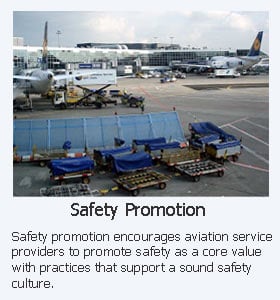Proactive Risk Management a Dream for Many Aviation Safety Programs

Historically, aviation safety management strategies relied predominantly upon reactive risk management principles. For example, a critical part would break or an accident occurred, and managers would then attempt to determine the root cause and fix the issue.
In a perfect world, aviation service providers will lean toward a more modern proactive, organizational-based methodology to avert serious accidents before they occur. By looking at Boeing stats, commercial traffic is very safe, with greater than 99.999% accident-free rate.
But there is always room for improvement because when a large aircraft splatters on the tarmac, hundreds of lives are jeopardized.
Safety managers are constantly challenged with moving their airlines and airports from a reactive culture to a more proactive risk management culture. But in order to make this transition, they must first overcome some very large hurdles.
Related Aviation Risk Management Articles
- Difference Between Reactive, Predictive and Proactive Risk Management in Aviation SMS
- How to Practice Reactive, Proactive, and Predictive Risk Management in Your Safety Program
- Is Root Cause Analysis Proactive or Reactive?
Poor Reporting Cultures Hinder Modern Risk Management Efforts
Accident-free does not mean "incident-free." What doesn't go into these accident reports are the close calls and countless unreported "irregularities." While the banking and medical industries attempt to keep a tight lid on their "bungles," I don't feel this is the case with the aviation industry. The problem stems from poor safety reporting cultures which are a detriment to the proactive phase of risk management.
Improving Hazard Reporting Culture
Major aviation accidents don't occur in a vacuum. There are usually many smaller incidents and irregularities that lead up to the "big one." Safety teams working in organizations with poor reporting cultures have little concrete data to examine to prepare the aviation service provider for the impending "big one."
So whose fault is this "poor hazard reporting culture?" We can say it is ultimately the responsibility of top management, which is the accountable executive. For every aviation SMS, accountable executives are responsible:
- Ensure their SMS is implemented correctly and performing as designed;
- Regularly review organizational safety performance and mitigate substandard safety performance.
The accountable executive has ultimate responsibility. Yet if the safety manager has been with the organization for more than two years, and the safety manager purportedly has top management support, I propose that the safety manager bears some responsibility.
For safety managers with poor hazard reporting metrics, there is plenty of documentation on the Internet regarding tips to improve reporting cultures and developing a just culture, which will
- Increases safety reporting;
- Builds trust between employees and management; and
- Enhances both safety and operational management effectiveness.
Related Articles on Aviation Safety Culture
- What Is Safety Culture in the Aviation Industry?
- Indicators of Good Hazard Reporting Culture
- How Top Management Kills Your Aviation Safety Culture
Poor Tools Prevent Safety Managers Moving to Proactive Phase
Hazard Reporting Tools

Poor hazard reporting tools thwart active hazard reporting. For example, when employees are unable to receive feedback that their hazard reports have been received, there is little incentive for them to continue reporting.
Furthermore, employees need simple, effective tools to report hazards, such as:
- Email reports feeding into a centralized database;
- Mobile apps for reporting hazards; and/or
- Web-based hazard reporting tools.
If hazard reporting is not simple, you cannot expect employees to regularly contribute to your safety program. One of the biggest challenges to hazard reporting is creating safety reporting forms that both:
- Capture enough information for safety teams to perform investigation; and
- Don't overwhelm reporters with long, tedious reporting processes.
An aviation SMS should appear professional and not "home-jobby" looking. Employees can tell whether a "company program" is important to management by many factors, including management's attitude to supporting the SMS. At your company, do other programs receive disproportionate funding and attention from upper management when the SMS is cobbled together with paper reporting forms and spreadsheets?
Employees know when management is not earnest and are merely trying to check the box. I'm not saying that "checking the box" is always a bad thing. There may be valid business reasons to simply check the box and have a "paper SMS." Considerable time and energy are required to implement a performing SMS, so this is a business decision that must be determined by management's goals and objectives.
Data Analysis Tools
A top indicator of top management support is a safety program budget, including the budget for aviation safety management software. MS Excel and Word are not considered top-end SMS software tools. Modern aviation SMS software tools are not that expensive when one considers the time and energy saved.
Without adequate risk management tools, safety managers will not regularly create and review reports needed to detect trends and develop mitigation strategies.
Paper and spreadsheets have their uses, but you should not rely on spreadsheets to store safety report data. The Europeans no longer allow spreadsheets to be the technology to store safety occurrence data. So if you are operating under EASA jurisdiction and complying with their SMS regulations, you will need more than spreadsheets. You will need a database to store your safety occurrence report data.
Safety managers who are stuck to spreadsheets because management has other budget priorities won't be able to perform in-depth data analysis on safety data. For very small operators, this may not be a concern.
Very small operators commonly don't have enough historical data to perform trend analyses that will add much analytical value. How big of an operation should you be before you quit using spreadsheets? Aviation service providers with more than 50 employees should be using a database. Operators under EASA jurisdiction don't have much choice - get the SMS database. There are other reasons besides analyzing trends, but this is the biggest reason if you wish to benefit fully from your SMS.
Related SMS Trend Analysis Articles
- Aviation Safety Managers' Best Friend - Trending Charts
- How to Use Trending Charts in Aviation SMS
- Six Steps How to Perform Trend Analysis in Aviation SMS
Safety Promotion Tools

Healthy reporting cultures are required for operators to move into the proactive risk management phase of modern aviation safety management systems.
Healthy reporting cultures are nourished by safety promotion activities, such as:
- Regular safety meetings;
- Message board announcements;
- Initial & recurrent SMS training;
- Safety newsletters;
- Safety surveys; and
- Lessons learned libraries.
Whenever safety managers spend inordinate amounts of time on any one of these activities, there is a strong possibility that the other important safety activities will not be completed. In short, effective safety promotion activities enhance hazard reporting, which in turn provides safety managers with data that can be trended. These trends can point to shortcomings and help identify leading indicators to predict future events.
Without adequate aviation risk management tools, safety managers will remain stuck in the reactive phase of aviation risk management.
There are many companies today offering low-cost, commercially available SMS databases. A word of caution. Don't get a point solution or one of the cheaper SMS databases that only address a portion of SMS requirements. There are SMS databases that provide the ability to manage all SMS requirements from planning to implementation to safety performance monitoring and measurement.
I would recommend an SMS database that can replace at least two other systems in your company. For example, you may already have point solutions for:
- Hazard reporting;
- Electronic message board; and
- Auditing.
In this case, look for SMS databases that also address these business requirements. The best SMS data management strategy is to be able to manage all SMS requirements in a centralized database. This will afford you the most sustainable option to move from a reactive risk management culture to practice the more desired proactive and predictive phases.
Related Aviation SMS Database Articles
- What Is an Aviation Safety Database
- How to Choose the Best Aviation Safety Database Software
- How to Manage Aviation Safety Programs Without Complex SMS Databases
Final Words for Moving From Reactive to Proactive Risk Management
Proactive risk management is the ultimate goal of all safety teams. For this goal to be achieved, safety managers must have:
- Healthy reporting cultures; and
- Modern aviation SMS software tools.
Without these two elements, your company will remain forever in the reactive phase.
The intent of an SMS is not to needlessly burden aviation service providers with more regulatory hoops to jump through, but to offer value to operators while simultaneously reducing accidents and losses from avoidable incidents.
SMS is a system. To benefit from an SMS, you have to work through the process. If you are still unclear as to the process, I recommend that you research the interaction between "Safety Risk Management" and "Safety Assurance."
Full-featured aviation SMS database tools help safety managers during their SMS implementations. Furthermore, a good SMS database allows accountable executives to easily monitor the performance of their SMS.
Can your accountable executive easily monitor your SMS performance and demonstrate continuous improvement of the SMS? If not, we can help.
Prefer to Watch SMS Demo Videos First?
Before requesting a live demo, we recommend that you watch these demo videos. You will be better prepared to ask the right questions after watching these short demo videos.
Last updated March 2025.





